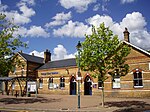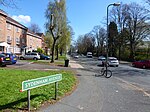Free Watermen and Lightermen's Almshouses
Almshouses in LondonGrade II listed buildings in the London Borough of BromleyGrade II listed houses in LondonHistory of the London Borough of BromleyHouses in the London Borough of Bromley ... and 4 more
London building and structure stubsResidential buildings completed in 1841Tudor Revival architecture in EnglandUse British English from June 2015

The Free Watermen and Lightermen's Almshouses (generally known as the Royal Watermen's Almshouses) on Beckenham Road / Penge High Street, Penge, London Borough of Bromley were built in 1840–1841 to designs by the architect George Porter by the Company of Watermen and Lightermen of the City of London for retired company freemen and their widows. It is the most prominent and oldest of the Victorian almshouses in Penge. In 1973, the almspeople were moved to a new site in Hastings, and the original buildings were converted into private homes. They have been Grade II listed since 1973.
Excerpt from the Wikipedia article Free Watermen and Lightermen's Almshouses (License: CC BY-SA 3.0, Authors, Images).Free Watermen and Lightermen's Almshouses
Barson Close, London Penge (London Borough of Bromley)
Geographical coordinates (GPS) Address Nearby Places Show on map
Geographical coordinates (GPS)
| Latitude | Longitude |
|---|---|
| N 51.4166 ° | E -0.0538 ° |
Address
St John the Evangelist
Barson Close
SE20 7EQ London, Penge (London Borough of Bromley)
England, United Kingdom
Open on Google Maps










